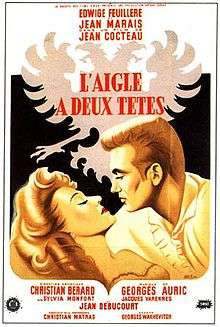The Eagle with Two Heads
| The Eagle with Two Heads | |
|---|---|
 | |
| Directed by | Jean Cocteau |
| Produced by |
Georges Dancigers Alexandre Mnouchkine |
| Written by | Jean Cocteau |
| Starring |
Edwige Feuillère Jean Marais Jean Debucourt Silvia Monfort Jacques Varennes |
| Music by | Georges Auric |
| Cinematography | Christian Matras |
| Edited by |
Claude Ibéria Raymond Leboursier |
Release dates |
France: 22 September 1948 United States: 18 December 1948 |
Running time | 93 min. |
| Country | France |
| Language | French |
The Eagle with Two Heads (French title L'Aigle à deux têtes) is a French film directed by Jean Cocteau released in 1948. It was adapted from his own play L'Aigle à deux têtes which was first staged in 1946, and it retained the principal actors from the first Paris production.
Synopsis
On the 10th anniversary of the assassination of the king, his reclusive widow, the Queen, arrives to spend the night at the castle of Krantz. Stanislas, a young anarchist poet who seeks to assassinate her, enters her room, wounded; he looks exactly like the dead king, and the Queen shelters him instead of handing him over to the police. She sees him as the welcome embodiment of her own death, calling him Azrael (the angel of death). An ambiguous love develops between them, uniting them in a bid to outwit the machinations of the court politicians, represented by the Comte de Foëhn, the chief of police, and Édith de Berg, the Queen's companion. In order to remain true to their ideals and to each other, the Queen and Stanislas have to play their parts in a bizarre private tragedy, which the world will never understand.
Cast
- Edwige Feuillère as the Queen
- Jean Marais as Stanislas
- Silvia Monfort as Édith de Berg
- Jean Debucourt as Félix de Willenstein
- Jacques Varennes as Comte de Foëhn
- Ahmed Abdallah as Tony
- Yvonne de Bray as La présidente
Production
Cocteau's play was produced in Paris in 1946 and 1947, and his decision to make a prompt adaptation for the cinema allowed him to retain the principal actors who had enjoyed personal successes with their roles, especially Edwige Feuillère and Jean Marais. Cocteau declared his intention of following the three-act structure of the play closely, citing his admiration of the methods of Ernst Lubitsch,[1] but he opened out some of the scenes into a wider variety of locations. Filming began in October 1947 at the Château de Vizille,[2] and further shots were filmed at the Studio d'Épinay on the outskirts of Paris.
Christian Bérard supervised the art direction, and the sumptuous sets and costumes (executed by Georges Wakhévitch and Marcel Escoffier respectively) evoked a royal palace in an imaginary kingdom of 19th century middle-Europe. Georges Auric expanded the music which he had written for the stage production into a full score for the film.
Reception
The film was released in Paris in September 1948. Its reception among French critics was mixed. It was appreciated for the sumptuous quality of its spectacle and for the elevated performances of its actors.[3] Others however felt that its artificiality belonged to another age and another medium, and that Cocteau had not sufficiently emancipated his film from its theatrical origins.[4][5]
When the film was shown in New York in 1948 and in London in 1949, the reviewers of both The New York Times and The Times shared a similar perplexity about the film's meaning and purpose.[6][7] The film has in general not enjoyed the same attention as the others which Cocteau directed in the 1940s.
References
- ↑ Jean Cocteau, in Combat, 21 August 1947, quoted in Claude-Jean Philippe, Jean Cocteau. (Paris: Seghers, 1989) p.160: "À l'exemple de Lubitsch, que j'admire beaucoup, le film suivra la pièce de très près. Je l'ai construit autour des trois scènes principales".
- ↑ René Gilson, Jean Cocteau cinéaste. (Paris: Éditions des Quatre-Vents, 1988) p.26.
- ↑ E.g. Louis Chauvet, Le Figaro, 26 August 1948, quoted in Claude-Jean Philippe, Jean Cocteau. (Paris: Seghers, 1989) p.162: "Les personnages parlent une langue toujours belle, et mêmes leurs attitudes sont belles".
- ↑ André Bazin, Parisien, 29 September 1948, quoted in Claude-Jean Philippe, Jean Cocteau. (Paris: Seghers, 1989) p.160: "L'Aigle à deux têtes laisse indifférent comme un motif décoratif habilement inspiré du style d'une autre époque".
- ↑ Jean Néry, L'Écran français, quoted in Claude-Jean Philippe, Jean Cocteau. (Paris: Seghers, 1989) p.162: "Il n'a pas su (ou pas voulu) s'émanciper des disciplines théâtrales".
- ↑ Bosley Crowther, "L'Aigle à deux têtes", in New York Times, 30 December 1948: "It sometimes helps if a reviewer has a faint idea of what a film he is reviewing is supposed to be about... Unfortunately, Mr Cocteau neglected to make it clear... Plenty of money and taste have plainly been spent on a handsome physical production. Hapsburg [sic] splendor is in the sets and the costumes which Miss Feuillere fills out are lovely and flattering. But they all add up to nothing."
- ↑ The Times (London), 10 November 1949, p.7, col.C: "The passion of Cocteau for history and for legend, his conception of illusion and reality, his preoccupations with death and doom, his romantic mysticism, so heavy and overcharged that it is difficult to remember that he is a French and not a Teutonic director - all these are indeed present in this new film, but fitfully, as it were, as inadequate exponents of the mood and the motive of the initial impulse. The play may have made things clearer...".
External links
- L'Aigle à deux têtes at the Internet Movie Database
- L'Aigle à deux têtes at AllMovie
- L'Aigle à deux têtes at the British Film Institute's Film and TV Database
- L'Aigle à deux têtes at filmsdefrance.com